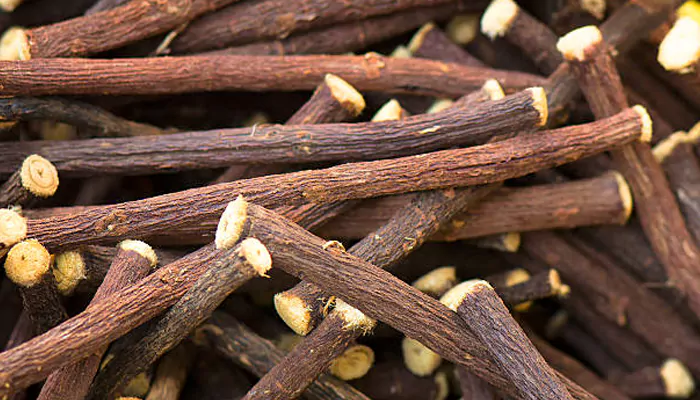Ayurveda Aaj - Licorice Magic: Ayurvedic Benefits and Simple Ways to Enjoy It Daily
- Devyani
- 1 year ago
- 4 minutes read

Rich in antimicrobial, anti-inflammatory, and anti-oxidative properties, the roots of Licorice have been widely used for centuries to treat various health issues.
Popularly known as Mulethi or Sweetwood, Licorice (Glycyrrhiza Glabra) is a medicinal plant which has been used for centuries to treat various health ailments like stomach problems, respiratory diseases, and inflammation. It's the roots of Licorice which are valued the most due to the presence of bioactive compounds like flavonoids, Glycyrrhizin, and polysaccharides.
Although Licorice confers numerous health benefits, its dosage should be limited as an excessive consumption of this medicinal plant can have many severe side effects like cardiac arrhythmias. This is because Licorice has an abundance of Glycyrrhizin acid which stops the conversion of cortisol to cortisone. This leads to an impaired kidney function and disrupts their ability to eliminate excess potassium. Licorice being an exceptionally beneficial medicinal plant, should be consumed in the right amount. Therefore, it is always advisable to consult your doctor before deciding on the dose of this medicinal plant.

In this article today, we will learn the health benefits of Licorice and ways we can easily incorporate it into our lifestyle.
The Numerous Health Perks of Licorice
A Clean Sweep for Microorganisms
Various types of bacteria like Salmonella, E.coli, Pseudomonas aeruginosa, Staphylococcus aureus and Streptococcus pyogenes are susceptible to the compounds found in Licorice. You can prepare both alcoholic and aqueous extract of this plant, and they will be equally effective against microorganisms.
Furthermore, Licorice has shown antifungal properties as well. It may be beneficial in eliminating drug-resistant Candida albicans infections. Additionally, research carried out on HIV patients show that Licorice is effective against fungal infections inside the mouth.
Guards Against Oxidative Stress

Licorice contains chemicals like glabridin, apigenin, and liquiritin. According to several laboratory studies, these substances present in the plant have shown effective antioxidant properties.
Keeps Your Blood Sugar in Check
Tests were carried out on rats, and it showed that Licorice has the ability to regulate blood sugar levels in patients with diabetes. Furthermore, numerous studies support that Licorice can reduce the common symptoms of diabetes, like excessive thirst and the frequent urge to urinate.
A Natural Defense Against Malaria

Lycochalcone A, a compound found in Licorice, shows high anti-malarial properties, and has the ability to eliminate malaria causing parasites from the body without causing any side effects. In China, three different species of Licorice are incorporated in pharmacy reference guidelines as a free treatment against Malaria.
Supports a Resilient Immune Response
Laboratory research has proven that Licorice has the ability to increase the production of certain lymphocytes and macrophages which are essential for the immune response in our body to function. Furthermore,. Licorice contains antiviral properties and safeguards the body from viral infections like Influenza.
Soothes Inflammation with Every Sip

Certain studies have shown that Licorice exhibits a more robust anti-inflammatory action than hydrocortisone, which is a type of corticosteroid widely employed in the treatment of inflammation like arthritis and several skin problems. Unlike medical anti-inflammatory drugs, Licorice does not affect the stomach lining.
Guardian of Gut Health
Carbenoxolone is a synthetic compound primarily used for treating gastric ulcers. It was developed with a structure resembling a compound found in licorice root, which is known for its protective effects on the stomach. Additionally, glycyrrhizic acid, another component from licorice, has demonstrated hepatoprotective properties. It can help reduce liver cell inflammation and may also play a role in preventing liver cancer development.
Breathe Easy, Say Goodbye to Phlegm

Several studies demonstrate that Licorice is effective in alleviating irritation in the throat area, and promoting the elimination of phlegm. This medicinal has been widely used traditionally to treat respiratory infections like wet coughs and bronchitis.
How to Take Licorice: Easy, Effective Ways to Incorporate the Medical Plant in Your Routine
Licorice is valued for its roots, from where the active compounds of the plants are extracted. The most common use of Licorice is tea.
Licorice Tea
Ingredients
- 5 g of licorice root
- 500 ml of water
Directions
Boil 500 ml of water with 5 grams of Licorice root in it for 10-15 minutes. Then leave to cool before straining. Drink up to 2 cups of Licorice tea a day.
Licorice Capsule
Licorice can be consumed for medicinal purposes, and the best way to do so is to use Licorice capsules. Your medical professional will prescribe the best dose according to the problem to be treated. Generally, the dose prescribed is 150 to 300 mg. Since Licorice has many side-effects, it is recommended that you do not exceed the daily dose of 500 mg.
Licorice confers numerous health benefits and has been widely used in particular for the treatment of respiratory ailments and as an antimicrobial agent. To avoid its side effects, always consult a doctor for the right dosage.












